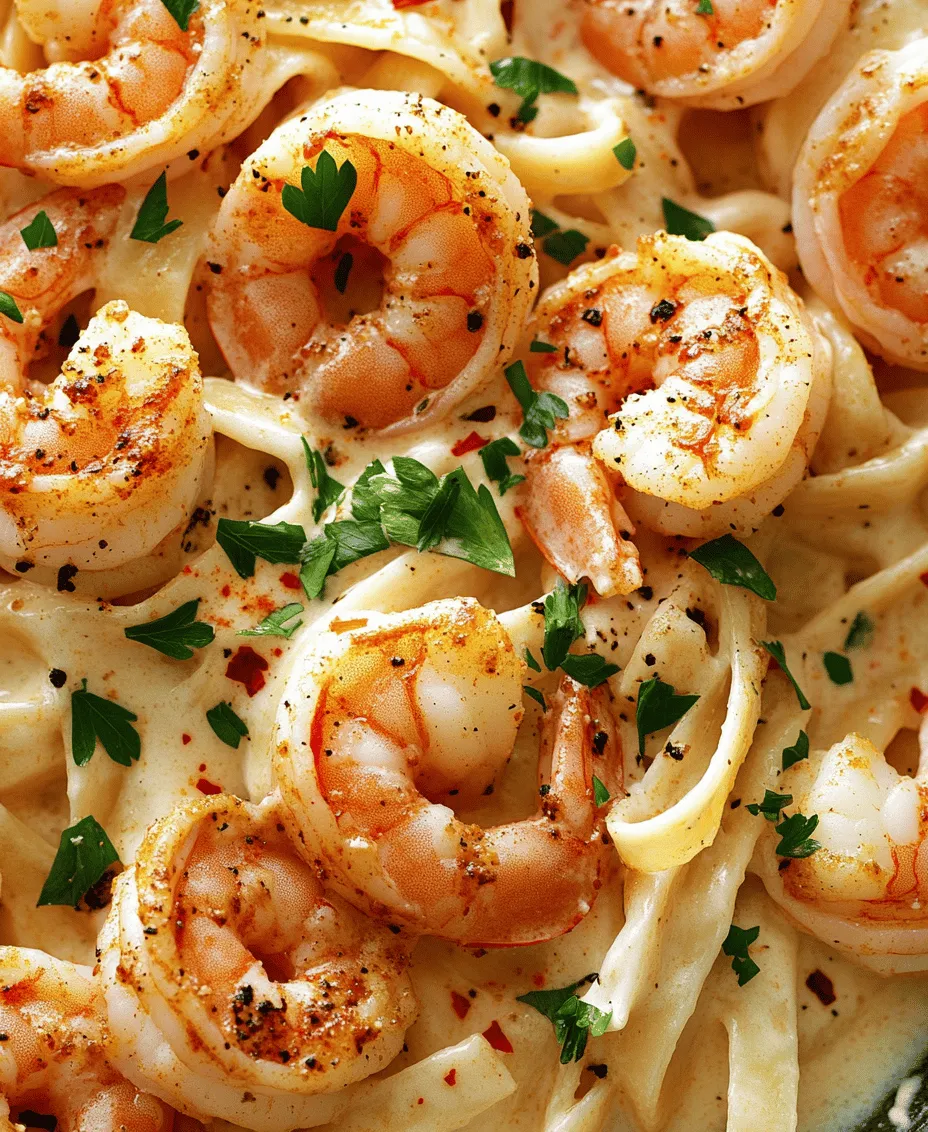Introduction
Cajun Fettuccine Alfredo is an irresistible dish that marries the creamy, comforting essence of traditional Italian fettuccine Alfredo with the bold, spicy character that epitomizes Cajun cuisine. This fusion creates a culinary experience that is as exciting as it is delicious, making it a standout choice for dinner parties or a cozy night at home. As people increasingly seek out new flavor adventures, Cajun cuisine has surged in popularity, celebrated for its vibrant flavors and hearty ingredients.
The heart of Cajun cooking lies in its rich history, drawing from a blend of French, African, Spanish, and Native American influences. This background has paved the way for the signature spices and techniques that define Cajun dishes. In this recipe, the classic fettuccine Alfredo is transformed by the addition of fresh, succulent shrimp and a medley of aromatic herbs and spices. Together, these elements create a dish that is not only visually appealing but also tantalizing to the taste buds, making it a must-try for food enthusiasts eager to explore the depths of flavor.
Understanding Cajun Cuisine
To appreciate Cajun Fettuccine Alfredo fully, we must delve into the roots of Cajun cooking. Originating from the Acadian people who settled in Louisiana, Cajun cuisine is known for its rustic, hearty dishes that utilize local ingredients. The cuisine is characterized by its use of spices, fresh seafood, and a variety of meats, often cooked in a single pot for maximum flavor. Cajun cooking emphasizes not only the taste but also the culture, with each recipe telling a story of the region’s diverse heritage.
One of the hallmarks of Cajun cuisine is its distinctive seasoning blend. Common spices include paprika, cayenne pepper, garlic powder, onion powder, thyme, and oregano. This combination creates a flavorful base that enhances the natural flavors of the ingredients, bringing warmth and depth to each dish. When it comes to Cajun Fettuccine Alfredo, the addition of Cajun seasoning elevates the creamy sauce, transforming it into a spicy, savory delight that perfectly complements the richness of the pasta.
Cajun cuisine also embraces fresh ingredients, whether it’s the seafood sourced from the Gulf of Mexico or the vibrant vegetables commonly found in the region. The commitment to using high-quality, fresh produce ensures that every bite bursts with flavor, making the dining experience memorable. This emphasis on bold flavors and freshness sets the stage for our recipe, where Cajun spices meet the creamy, indulgent sauce of Fettuccine Alfredo.
Ingredients Breakdown
Creating a delicious Cajun Fettuccine Alfredo requires a careful selection of ingredients that will work harmoniously together. Here is a comprehensive list of what you need:
Ingredients
– Fettuccine Pasta (12 ounces): The star of the dish, fettuccine offers a wide, flat surface that beautifully holds onto the creamy Alfredo sauce.
– Shrimp (1 pound, peeled and deveined): Fresh shrimp adds a touch of the sea, complementing the richness of the sauce and bringing a delightful texture.
– Butter (4 tablespoons): Essential for creating the base of the creamy sauce, butter adds richness and depth of flavor.
– Heavy Cream (1 cup): The key ingredient in Alfredo sauce, heavy cream provides the luxurious creaminess that makes this dish so indulgent.
– Parmesan Cheese (1 cup, grated): A must-have for authentic Alfredo sauce, Parmesan adds a salty, nutty flavor that balances the cream.
– Cajun Seasoning (2 tablespoons): This blend of spices brings the bold flavors of Cajun cuisine to the dish, infusing it with warmth and complexity.
– Garlic (4 cloves, minced): Fresh garlic enhances the sauce with its aromatic qualities and complements the shrimp perfectly.
– Green Onions (for garnish): Adding a fresh, oniony crunch, green onions make for a vibrant garnish that elevates the presentation.
– Salt and Pepper (to taste): Essential seasonings to enhance the overall flavor of the dish.
Ingredient Roles
Understanding the role of each ingredient is crucial for achieving the best possible outcome. The fettuccine serves as the foundation, while the shrimp provides protein and depth. Butter and heavy cream combine to create the rich sauce, with Parmesan cheese offering a creamy, savory finish. The Cajun seasoning is the star here, transforming a classic dish into something exciting and unique. Finally, garlic adds a fragrant note, making every bite irresistible.
For dietary preferences or restrictions, consider substituting the shrimp with grilled chicken or sautéed mushrooms for a vegetarian option. You can also use gluten-free pasta if you’re looking to make this dish suitable for gluten-sensitive diners.
Step-by-Step Cooking Instructions
Now that we have our ingredients ready, let’s guide you through the cooking process with clear, easy-to-follow instructions. Each step is designed to ensure that you achieve the perfect Cajun Fettuccine Alfredo.
Cooking the Fettuccine
1. Boil Water: Start by filling a large pot with water and bringing it to a rolling boil. Add a generous pinch of salt to the water, which enhances the flavor of the pasta.
2. Cook the Pasta: Once the water is boiling, add the fettuccine. Stir occasionally to prevent sticking, and cook according to the package instructions until al dente, usually around 8-10 minutes.
3. Reserve Pasta Water: Before draining the pasta, remember to reserve about a cup of the starchy pasta water. This water can be crucial for adjusting the consistency of your sauce later on.
4. Drain and Set Aside: Drain the pasta in a colander and set it aside. Do not rinse the pasta, as this will remove the starch that helps the sauce adhere.
Sautéing the Shrimp
1. Heat the Pan: In a large skillet, melt 2 tablespoons of butter over medium-high heat. Ensure that the pan is hot enough to give the shrimp a nice sear without overcooking.
2. Add the Shrimp: Once the butter is melted and bubbling, add the shrimp to the pan in a single layer. Do not overcrowd the pan, as this will steam the shrimp instead of sautéing them.
3. Season and Cook: Sprinkle half of the Cajun seasoning over the shrimp and sauté for about 2-3 minutes on one side until they turn pink and opaque. Flip the shrimp and add the minced garlic, cooking for another 1-2 minutes. The garlic should become fragrant but not browned.
4. Remove Shrimp: Once fully cooked, remove the shrimp from the skillet and set them aside on a plate. This step is essential to prevent overcooking, as the shrimp will continue to cook in the residual heat.
By following these initial steps, you are laying the groundwork for a truly delicious Cajun Fettuccine Alfredo. The combination of perfectly cooked fettuccine and succulent shrimp, infused with the bold flavors of Cajun spices, sets the stage for the creamy sauce that will bring everything together. As we continue with the recipe, we’ll delve into the creation of the Alfredo sauce, ensuring that every element shines in this flavor explosion.

The Impact of Cajun Seasoning on Shrimp
Cajun seasoning is a vibrant blend of spices that brings a distinctive, bold flavor to any dish it touches, and in this Cajun Fettuccine Alfredo, it works wonders with shrimp. The mix typically includes paprika, cayenne pepper, garlic powder, onion powder, thyme, oregano, and black pepper, creating a taste that is both spicy and aromatic. When you coat the shrimp in this seasoning, the result is a beautiful balance of heat and flavor that elevates the entire dish.
As the shrimp cook, they absorb the spices, which not only enhances their natural sweetness but also infuses the Alfredo sauce with a hint of smokiness and spice. This dynamic interaction between the Cajun seasoning and shrimp creates an irresistible flavor explosion, making every bite of your fettuccine an experience to savor.
Creating the Alfredo Sauce
Now that your shrimp are seasoned and cooked to perfection, it’s time to dive into creating the creamy Alfredo sauce that will tie everything together. Start by melting a generous amount of butter in a large skillet over medium heat. Once the butter is melted, add minced garlic and sauté for 1-2 minutes until fragrant, being careful not to let it brown, as burnt garlic can impart a bitter taste.
Next, pour in the heavy cream, raising the temperature slightly to bring it to a gentle simmer. The heavy cream is crucial for achieving that rich, velvety texture that Alfredo is known for. Stir the cream continuously, allowing it to reduce slightly, which will help thicken the sauce.
Once the cream has simmered for about 5 minutes, gradually whisk in freshly grated Parmesan cheese. It’s important to use fresh cheese instead of pre-grated, as the latter often contains anti-caking agents that can prevent the cheese from melting smoothly. Keep stirring until the cheese is fully melted and incorporated, creating a luscious sauce.
The key to a perfect Alfredo sauce lies in the stirring and simmering process. Stirring ensures that the sauce remains smooth, while simmering allows the flavors to meld beautifully. If you find the sauce too thick, don’t hesitate to adjust its consistency by adding a bit of the reserved pasta water. This not only thins the sauce to your desired consistency but also helps the sauce cling better to the pasta.
Combining Everything
With the shrimp sautéed and the Alfredo sauce perfected, it’s time to bring all the components together. Begin by adding the cooked fettuccine directly into the skillet with the Alfredo sauce. Using tongs, gently toss the pasta in the sauce, ensuring every strand is coated in the creamy mixture. This step is where the magic happens—allowing the flavors of the Cajun shrimp and the rich Alfredo to meld together.
If you find the dish a bit bland at this stage, don’t hesitate to experiment with additional seasoning. A sprinkle of Cajun spice or a dash of salt and pepper can enhance the dish further, allowing you to tailor the heat and flavor to your personal preference.
Once the pasta is well coated, fold in the sautéed shrimp, ensuring they are evenly distributed throughout the dish. This careful combining technique ensures that every bite of your Cajun Fettuccine Alfredo is bursting with flavor.
Serving Suggestions
When it comes to serving your Cajun Fettuccine Alfredo, presentation is key. Aim for generous portions, and consider twirling the fettuccine into nests on the plate for an elegant touch. Garnishing your dish with freshly chopped parsley not only adds a splash of color but also a fresh flavor that balances the richness of the sauce. A sprinkle of extra Parmesan cheese can also enhance the visual appeal and add another layer of cheesy goodness.
For a complete meal, consider serving your Cajun Fettuccine Alfredo with complementary side dishes. Garlic bread is a classic choice, perfect for soaking up any leftover sauce, while a crisp, fresh salad can provide a refreshing contrast to the rich pasta. A light vinaigrette can enhance the salad’s flavor, making it a delightful accompaniment.
Nutritional Information
Cajun Fettuccine Alfredo is a rich dish that contains a balance of protein, carbohydrates, and fats. The shrimp provide a significant protein punch, making this dish not only delicious but also satisfying. A typical serving contains around 500-600 calories, depending on portion size and the amount of cream and cheese used.
The carbohydrates from the fettuccine serve as a great energy source, while the heavy cream and Parmesan cheese contribute to the dish’s richness and creaminess. Additionally, including parsley not only adds flavor but also offers nutritional benefits, as it is rich in vitamins A, C, and K, alongside essential minerals.
While this dish can be enjoyed as part of a balanced diet, moderation is key due to its higher fat content. Consider serving smaller portions or pairing it with lighter fare to balance your meal.
Conclusion
Preparing and enjoying Cajun Fettuccine Alfredo is a delightful experience that combines the richness of traditional Alfredo with the bold, spicy flavors of Cajun cuisine. Each step, from seasoning the shrimp to creating the perfect creamy sauce, contributes to a dish that is both comforting and exciting.
This fusion of flavors creates a unique culinary experience that is sure to impress family and friends. Embrace the joy of cooking this dish and share it with those you love, celebrating the beautiful blend of cultures that come together on your plate. With its vibrant taste and satisfying texture, Cajun Fettuccine Alfredo is not just a meal; it’s a flavor explosion that invites everyone to gather around the table and indulge in a delicious celebration of food.


